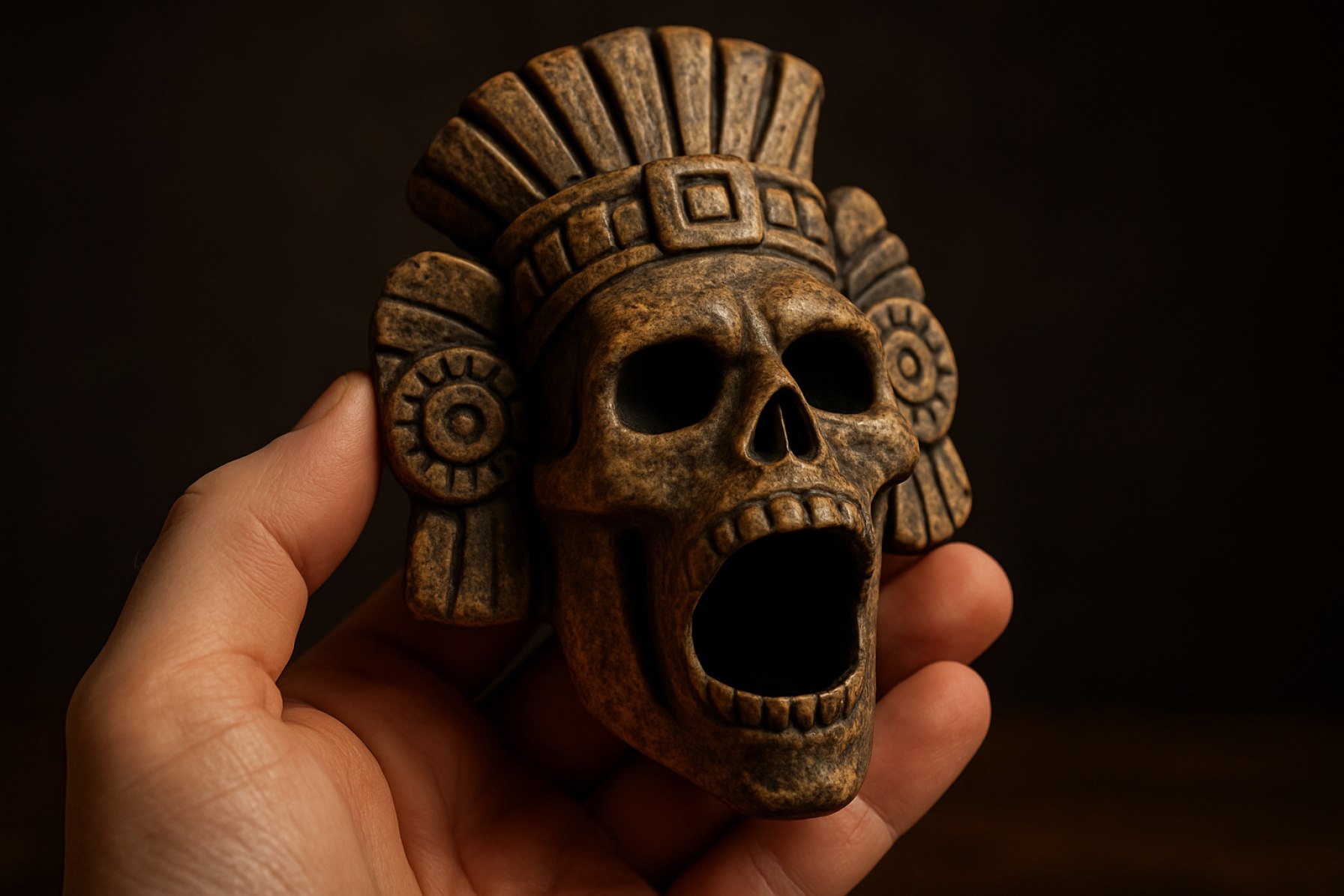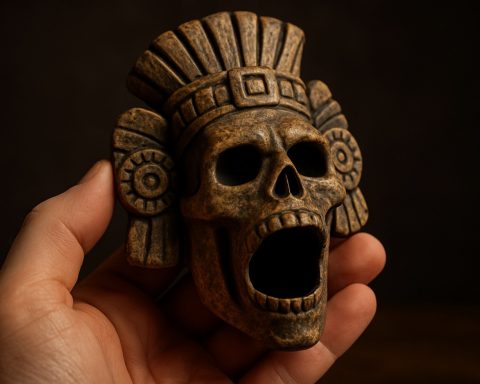The Aztec Death Whistle: Exploring the Bone-Chilling Instrument That Echoed Through Ancient Ceremonies. Discover Its Mysterious Origins, Haunting Sounds, and Cultural Significance.
- Introduction: What Is the Aztec Death Whistle?
- Historical Origins and Archaeological Discoveries
- Construction and Materials: How the Whistle Is Made
- The Haunting Sound: Acoustic Analysis and Modern Replications
- Ritualistic and Cultural Significance in Aztec Society
- Theories on Its Use: Warfare, Sacrifice, and Spiritual Purposes
- Modern Fascination: The Death Whistle in Popular Culture
- Conclusion: Legacy and Continuing Mystique
- Sources & References
Introduction: What Is the Aztec Death Whistle?
The Aztec Death Whistle is a unique and enigmatic artifact associated with the ancient Aztec civilization of Mesoamerica. Characterized by its skull-like appearance and the chilling, high-pitched sound it produces, the whistle has captured the imagination of archaeologists, musicians, and the public alike. Unlike typical musical instruments, the Aztec Death Whistle emits a sound often described as resembling human screams or howling wind, which has led to widespread speculation about its original purpose and cultural significance.
Discovered in archaeological contexts such as burials and ceremonial sites, the death whistle is typically crafted from clay and intricately decorated, sometimes in the form of a human skull. Its haunting sound is produced by a complex internal structure that manipulates airflow, creating a shrill, unsettling noise. While the exact historical use of the whistle remains debated, some researchers suggest it may have been employed in rituals, warfare, or as a psychological weapon to instill fear in enemies. Others propose its use in funerary practices or as a tool for spiritual communication.
The resurgence of interest in the Aztec Death Whistle in recent years has led to experimental reconstructions and acoustic analyses, deepening our understanding of its acoustic properties and potential functions. Despite ongoing research, the true role of the Aztec Death Whistle within Aztec society remains partially shrouded in mystery, highlighting the complexity and richness of Mesoamerican cultural heritage (Instituto Nacional de Antropología e Historia; Smithsonian Magazine).
Historical Origins and Archaeological Discoveries
The historical origins of the Aztec death whistle are shrouded in mystery, with its first documented archaeological discovery occurring in the late 20th century. The most notable find took place in the 1990s at the site of Tlatelolco, an ancient Aztec city-state in present-day Mexico City. Archaeologists uncovered a pair of ceramic whistles in the hands of a sacrificed male skeleton, suggesting a ritualistic context for their use. These artifacts were initially misidentified as toys or simple musical instruments, but subsequent research revealed their unique acoustic properties and potential ceremonial significance (Instituto Nacional de Antropología e Historia).
Further excavations across central Mexico have yielded additional examples of similar whistles, often found in association with temples, burial sites, and offerings. The whistles are typically crafted from clay and shaped to resemble skulls or other symbolic motifs, reinforcing their connection to death and the afterlife. Their distribution and context imply that they played a role in Aztec funerary practices, possibly intended to guide or frighten spirits during rituals dedicated to deities such as Mictlantecuhtli, the god of death (Museo Nacional de Antropología).
Despite these discoveries, the precise function and prevalence of the death whistle within Aztec society remain subjects of scholarly debate. The lack of direct references in surviving codices and colonial accounts complicates efforts to reconstruct its original use, leaving much to be inferred from archaeological context and experimental reconstructions (Universidad Nacional Autónoma de México).
Construction and Materials: How the Whistle Is Made
The construction of the Aztec death whistle is a testament to the ingenuity and craftsmanship of Mesoamerican artisans. Traditionally, these whistles are crafted from fired clay, a material widely available and easily shaped in pre-Columbian Central Mexico. Artisans begin by molding the clay into a hollow, globular or skull-shaped chamber, which serves as the resonating body of the instrument. The whistle’s distinctive, piercing sound is produced by a carefully engineered internal mechanism: a narrow air channel leads from the mouthpiece into the chamber, where a small, thin membrane or baffle is sometimes added to disrupt airflow and create the whistle’s signature shriek. The precise dimensions and placement of these internal features are crucial, as even minor variations can significantly alter the sound’s pitch and timbre.
Some surviving examples of Aztec death whistles are elaborately decorated, featuring carved motifs such as skulls, deities, or geometric patterns, which may have held ritual significance. The external design, however, does not affect the instrument’s acoustics. After shaping, the clay whistle is left to dry and then fired in a kiln to harden it, ensuring durability and resonance. Modern reconstructions often follow these traditional methods, though some use 3D printing or alternative materials for educational or experimental purposes. For more detailed information on the construction and archaeological findings of these instruments, see resources from the Instituto Nacional de Antropología e Historia and the British Museum.
The Haunting Sound: Acoustic Analysis and Modern Replications
The Aztec death whistle is renowned for its chilling, human-like scream, a sound that has captivated researchers and the public alike. Acoustic analyses reveal that the whistle produces a broad spectrum of frequencies, with a particular emphasis on high-pitched, discordant tones that mimic the timbre of a human scream or wail. This effect is achieved through the whistle’s unique internal structure, which includes a resonating chamber and a narrow air passage, creating turbulent airflow and complex sound waves. Studies using spectrograms and high-speed microphones have shown that the whistle’s sound can reach up to 125 decibels, comparable to a chainsaw or a live rock concert, and is particularly effective at startling listeners and evoking a sense of fear or urgency Smithsonian Magazine.
Modern artisans and researchers have replicated the Aztec death whistle using both traditional ceramic techniques and 3D printing technology. These replications allow for controlled experiments and public demonstrations, providing insight into the whistle’s possible uses in Aztec rituals or warfare. Some experiments suggest that a group of whistles played simultaneously could create a terrifying wall of sound, potentially used to intimidate enemies or enhance ceremonial experiences National Geographic. The ongoing study of these replicas continues to shed light on the sophisticated acoustic knowledge possessed by the Aztecs and the psychological impact of their sonic artifacts.
Ritualistic and Cultural Significance in Aztec Society
The Aztec death whistle holds profound ritualistic and cultural significance within Aztec society, extending far beyond its eerie sound. Archaeological findings suggest that these whistles were often placed in the hands of sacrificial victims or buried alongside the dead, indicating their role in funerary rites and beliefs about the afterlife. The sound produced by the whistle—described as a chilling, human-like scream—was likely intended to invoke the presence of deities associated with death, such as Mictlantecuhtli, the god of the underworld. This connection is supported by discoveries of death whistles at the temple of wind god Ehecatl, where sacrificial ceremonies were performed, highlighting their use in both death and wind-related rituals Instituto Nacional de Antropología e Historia.
In addition to funerary contexts, the Aztec death whistle may have been used to create an atmosphere of fear and awe during large-scale ceremonies, processions, or even in warfare to intimidate enemies. The instrument’s unique sound could symbolize the transition between life and death, serving as an auditory marker of spiritual transformation or the soul’s journey to the afterlife. Some scholars propose that the whistle’s use in ritual contexts was also intended to communicate with the spirit world, acting as a conduit between the living and the dead Museo Nacional de Antropología.
Overall, the Aztec death whistle exemplifies the intricate relationship between sound, ritual, and cosmology in Aztec culture, reflecting a worldview in which music and noise were powerful tools for shaping spiritual and communal experiences.
Theories on Its Use: Warfare, Sacrifice, and Spiritual Purposes
The Aztec Death Whistle has intrigued scholars and enthusiasts alike due to its haunting sound and mysterious origins. Several theories have emerged regarding its intended use, with the most prominent focusing on warfare, sacrificial rituals, and spiritual practices. One prevailing hypothesis suggests that the whistle was employed during warfare to intimidate enemies. Its piercing, shrill noise—often likened to human screams—could have been used en masse by Aztec warriors to create psychological terror on the battlefield, disrupting enemy formations and morale (Instituto Nacional de Antropología e Historia).
Another significant theory posits that the Aztec Death Whistle played a role in sacrificial ceremonies. Archaeological discoveries have found these whistles in the hands of sacrificial victims, indicating their possible use in rituals dedicated to deities such as Mictlantecuhtli, the god of death. The sound may have symbolized the soul’s journey to the underworld or served as an offering to appease the gods (Museo Nacional de Antropología).
A third perspective considers the whistle’s spiritual and healing applications. Some researchers propose that the instrument was used in shamanic practices to induce trance states, communicate with spirits, or guide souls in funerary rites. The unique acoustic properties of the whistle could have been believed to open portals between the physical and spiritual realms (Universidad Nacional Autónoma de México).
While definitive evidence remains elusive, these theories highlight the multifaceted significance of the Aztec Death Whistle within Aztec society, reflecting its potential roles in warfare, ritual sacrifice, and spiritual practice.
Modern Fascination: The Death Whistle in Popular Culture
The Aztec death whistle has captured the imagination of modern audiences, emerging as a striking symbol in popular culture. Its chilling, human-like scream has been featured in documentaries, viral internet videos, and even horror films, where it is often used to evoke fear and mystery. The whistle’s unique sound has inspired musicians and sound designers, who incorporate its haunting tones into experimental music and cinematic soundtracks. For example, the death whistle’s effect was highlighted in the soundtrack of the video game “Shadow of the Tomb Raider,” where it contributed to the atmospheric tension of Mesoamerican-inspired settings (Square Enix).
Beyond entertainment, the death whistle has become a subject of fascination among historians, archaeologists, and enthusiasts of pre-Columbian cultures. Replicas are widely available for purchase, and demonstrations of their sound are popular at museums and cultural festivals. Social media platforms, particularly YouTube and TikTok, have played a significant role in popularizing the whistle, with videos showcasing its terrifying sound garnering millions of views (YouTube). This widespread exposure has sparked debates about the whistle’s original use and meaning, blending scholarly inquiry with public curiosity.
The Aztec death whistle’s journey from ancient artifact to modern phenomenon illustrates how historical objects can be reinterpreted and reimagined, resonating with contemporary audiences far removed from their original context. Its presence in popular culture continues to fuel interest in Aztec history and the broader mysteries of Mesoamerican civilizations.
Conclusion: Legacy and Continuing Mystique
The legacy of the Aztec death whistle endures as a testament to the ingenuity and complexity of Aztec culture. Once shrouded in mystery, these artifacts have captured the imagination of scholars, musicians, and the public alike, due to their haunting sound and enigmatic purpose. While their exact historical use remains debated—ranging from ritualistic ceremonies to psychological warfare—their rediscovery has sparked renewed interest in pre-Columbian musical traditions and the broader spiritual worldview of the Aztecs. Modern reconstructions and performances have brought the chilling sound of the death whistle to contemporary audiences, highlighting the sophisticated acoustic knowledge possessed by its creators.
The continuing mystique of the Aztec death whistle is amplified by ongoing research and public fascination. Museums and academic institutions, such as the Museo Nacional de Antropología, have played a crucial role in preserving and interpreting these artifacts, while digital media has enabled their eerie tones to reach a global audience. The whistle’s legacy is not only archaeological but also cultural, inspiring artists, filmmakers, and musicians to explore its evocative power. As new discoveries and analyses emerge, the Aztec death whistle remains a symbol of the enduring mysteries of Mesoamerican civilizations and a reminder of the rich, multifaceted heritage they have left behind.









